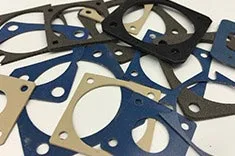EMI Shielding Products
- Custom Gasket Fabrication
- Connector Gaskets
- Bonded O Ring
- Custom Gaskets
- Conduct-O-Knit Knitted Wire Mesh
- Conduct-O-Seal Combo Gasket
- Conduct-O-Elastomer
- Conduct-O-Seal Oriented Wire in Silicone Gasket Material
- Conduct-O-Mesh Tape
- Conduct-O-Foam
- Conduct-O-Bond
- Optical Filters For Electronic Displays
- Shielded Vent Panels
- ESC Board Level Shielding
- 300 Series
Enhancing Polymer-Based EMI and RF Shielding Materials with Conductive Fillers
 As electronic devices increase, the challenge of electromagnetic interference (EMI) and radio frequency (RF) interference becomes increasingly critical. While effective, traditional metal-based shielding materials present numerous drawbacks, prompting researchers to explore polymer-based alternatives. A key innovation in this area is the incorporation of conductive fillers, which significantly enhance the shielding effectiveness of polymer-based materials. This development makes them a superior choice for various applications, including RF shielding.
As electronic devices increase, the challenge of electromagnetic interference (EMI) and radio frequency (RF) interference becomes increasingly critical. While effective, traditional metal-based shielding materials present numerous drawbacks, prompting researchers to explore polymer-based alternatives. A key innovation in this area is the incorporation of conductive fillers, which significantly enhance the shielding effectiveness of polymer-based materials. This development makes them a superior choice for various applications, including RF shielding.
EMI and RF Shielding with Conductive Fillers
- Conductive Fillers: The Versatile Solution for EMI and RF Shielding - Conductive fillers such as carbon nanotubes (CNTs), graphene, carbon black, and metal nanoparticles transform insulating polymers into highly effective materials for shielding EMI and RF interference. These fillers impart electrical conductivity to otherwise non-conductive polymers, enabling them to efficiently block or absorb electromagnetic waves. This transformation allows polymers to rival, and in some cases surpass, the performance of traditional metals in EMI and RF shielding.
- Carbon Nanotubes (CNTs) in EMI and RF Shielding - Carbon nanotubes are particularly noteworthy among the various conductive fillers due to their exceptional electrical conductivity and high aspect ratio. The unique structure of CNTs allows for a continuous conductive network within the polymer matrix at relatively low filler loadings. Consequently, this results in high shielding effectiveness with minimal addition to the weight of the material. Studies have demonstrated that even a tiny percentage of CNTs can drastically improve the performance of polymer composites in shielding EMI and RF interference, making them ideal for applications where lightweight and high performance are critical for RF shielding.
- Graphene and Graphene Oxide for EMI and RF Shielding - Graphene and its derivatives, such as graphene oxide, have garnered significant attention due to their high surface area and excellent electrical properties. These attributes enhance polymers' dielectric and magnetic loss properties, leading to superior EMI and RF shielding capabilities. Moreover, the incorporation of graphene can improve the mechanical properties of the polymer composite, providing additional benefits such as increased strength and flexibility. This makes graphene an excellent choice for RF shielding applications.
- Carbon Black and Metal Nanoparticles in RF Shielding - In addition to carbon nanotubes and graphene, carbon black, a cost-effective and readily available filler, is widely used to improve the conductivity of polymer composites. Its ability to form a conductive network within the polymer matrix at low concentrations makes it a popular choice for EMI and RF shielding applications. Similarly, metal nanoparticles such as silver, nickel, and copper offer high conductivity and can be used to tailor the shielding properties of polymer composites. Often used with carbon-based fillers, these metal fillers create hybrid materials that maximize the shielding effectiveness through reflection and absorption mechanisms. The reflection mechanism involves bouncing off the electromagnetic waves, while the absorption mechanism involves converting the energy of the waves into heat. This combination makes them ideal for RF shielding.
Customizable Shielding Properties for EMI and RF Interference
One key advantage of using conductive fillers in polymer-based EMI and RF shielding materials is the ability to customize the shielding properties to meet specific application requirements. These requirements could include high electrical conductivity, low weight, or specific mechanical properties. By varying the fillers' type, concentration, and distribution, manufacturers can tailor the composite material's electrical conductivity, mechanical strength, and overall shielding effectiveness. This customization is difficult to achieve with traditional metal-based shielding solutions, providing a significant advantage in designing materials for specialized applications, particularly in RF shielding.
Enhancing EMI & RF Shielding Options
Conductive fillers have revolutionized the field of polymer-based EMI and RF shielding materials, offering a versatile and effective alternative to traditional metal-based solutions. These fillers create lightweight, customizable, high-performance materials suitable for various applications by enhancing polymers' electrical conductivity and overall shielding effectiveness. As the demand for advanced EMI and RF shielding solutions grows, your role in driving further innovations and improvements in this critical area is crucial, making conductive fillers an increasingly important part of the future of materials science and engineering.



